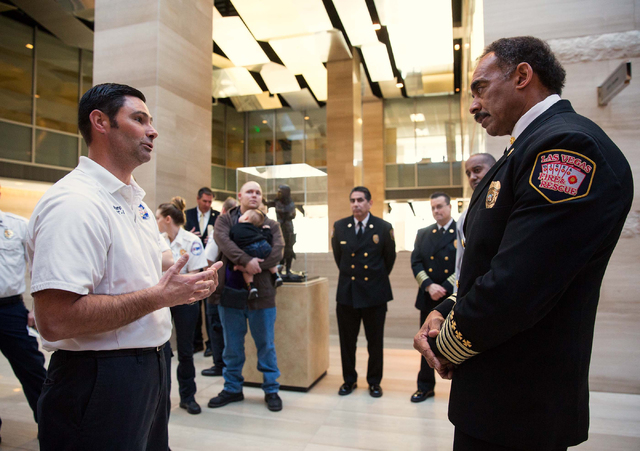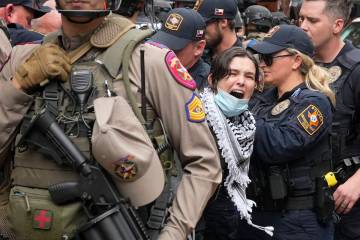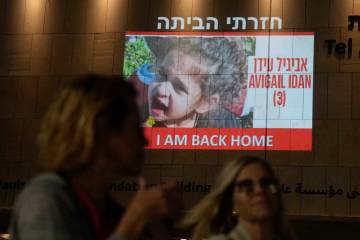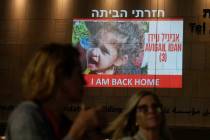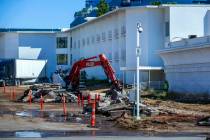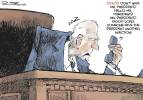AMR, Las Vegas Fire still at odds over ambulance services
The Las Vegas Fire Department and American Medical Response have dueled for three months over a new hospital transport policy that is pulling more money into city coffers and less into the private ambulance company’s.
Their weapons of choice have been reports and maps that have been scrutinized and criticized. Each side has accused the other of providing misleading information to the City Council and the news media. Recently, they even have refused to share information with one another, blocking further dueling reports.
But city officials haven’t indicated any willingness to change their opinion that it’s a wise plan to raise more money by having the Fire Department transport more patients to the hospital, though nobody knows how much it could cost the city in the long run.
The first allegation to draw attention was AMR’s report concluding the Fire Department was handling more hospital transports in wealthier areas.
Fire Chief Willie McDonald called a news conference May 13 and said AMR’s report was “completely false,” while admitting he hadn’t read it.
After reading it, he became more forceful in rebutting AMR’s report, which suggested that the department prefers taking patients to the hospital who are wealthier and better insured, leaving more of the poor ones to the private ambulance company.
Pen in hand, McDonald picked apart the initial map prepared by Applied Analysis, saying that by choosing to compare the 89110 ZIP code with Summerlin’s 89134, the analysts had chosen a ZIP code where 50 percent is not in the city but instead is in unincorporated areas of Clark County and that the county responds primarily to that area because there is no city fire station nearby.
Another ZIP code would have shown that the city is not declining to transport in poorer areas, the fire chief said.
“It is misleading and a misrepresentation of the facts,” McDonald said. “Even the map is misleading.”
Jeremy Aguero, a principal at Applied Analysis, defended the work done on the ambulance company’s behalf, but he ran the numbers again, using a grid in another ZIP code area — 89101. “No one wants to be misleading, that’s for sure,” he said.
Under the revised map, in 89101, AMR transported 60 percent of the calls in the lower income area, instead of 83 percent in 89110. The Fire Department transported 39 percent in the poorer area downtown, instead of 17 percent in the first calculation.
“The outcome is less extreme but similar,” Aguero said Tuesday, sticking by his initial conclusion that the Fire Department’s decision to transport patients is “favoring areas with higher incomes, less diversity, higher rates of insurance, and ultimately, higher expected emergency medical services collection rates.”
McDonald looked at the revised map and said the department, by transporting 39 percent in that area, was hitting the expected range, according to AMR’s own charts.
Two men, looking at the same information, reached different conclusions.
More startling, however, is McDonald’s assertion that AMR was “unable to respond” to emergency calls 248 times when called out by the Fire Department between March 3 and May 13. “We ask, they tell us they can’t send anyone.”
He showed a report that said AMR was called and answered “unable to respond” dozens of times. The call then bounced back to the Fire Department, though it asked for the help.
Tony Greenway, AMR’s operations manager, said the chief’s title on his map on that issue is misleading. “The title ‘unable to respond’ is misleading,” Greenway said. “It should have been called ‘mutual aid.’ ”
Turns out the two men define “mutual aid” differently.
The difference is irrelevant to patients. Every patient who needed an ambulance ride got one.
INFORMATION AND ACCOUNTABILITY
The two sides now aren’t sharing information.
On May 12, the Fire Department told FirstWatch, a private company which tracks all the Las Vegas 911 calls, to block the information from AMR.
It cited patient privacy required by the federal Health Insurance Portability and Accountability Act, also known as HIPAA. After all, patient addresses were included in the FirstWatch tallies.
McDonald also said that by sharing the information with Aguero, AMR violated a contract agreement limiting who has access.
Without the numbers, Aguero cannot update statistics and calculate how long it takes between a call into the department for emergency services and how long a delay before AMR is called. The latest numbers conclude it’s an average 9-minute wait before AMR is called out, presuming they are called out at all.
Aguero has information for April, but unless the Fire Department shares its information, he will be blocked from further analysis.
“The accountability is only there if the city chooses to provide the information,” Aguero said.
But city officials say Aguero won’t share his raw data with them so they could check his work.
Boils down to “you won’t show me yours, and I won’t show you mine.”
SORTING IT OUT
The woman expected to make sense of all these claims and counterclaims and advise the City Council is City Manager Betsy Fretwell. She hired McDonald last year, luring him away from San Jose, Calif.
She is sticking by McDonald and his plan to raise revenue for the city.
By September 2015, he wants the department to handle 75 percent of the transports, leaving AMR with 25 percent of the business.
Right now the department is handling 47 percent, and he projected it to hit 50 percent by July 1.
By increasing transports, the city estimates the department will bring in an additional $3.5 million next fiscal year.
The department responds to every medical emergency call, and there is no charge for responding by either the department or AMR. The financial benefit comes to whoever takes the patient to the hospital because that is where the billing comes in.
AMR would see its transport business cut from 70 percent to 25 percent.
Fretwell is 100 percent behind the change. “We’re staying the course,” she said.
She insisted that additional revenues will go into the city’s general fund, not to the Fire Department itself.
WHAT NEXT
“At some point the council has to weigh in on where do we go from here,” Fretwell said.
AMR’s franchise agreement will expire on Nov. 30, 2015, and the Fire Department plays a role in selecting a contract ambulance provider. After all these years with AMR, the city could decide to put out a request for a contract bid proposal.
The Fire Department cannot handle all the transports. Fretwell said it’s too early to tell if the private ambulance contract will go out for bid.
No one knows how this will play out in the end.
Will McDonald’s policy prevail or will AMR convince the City Council that this plan does not benefit the public?
The key number, the one no one has calculated, is how much of an increase will be needed in the Fire Department’s budget to handle 75 percent of the ambulance transports. Will the costs of hiring more firefighters and buying more ambulances and equipment outweigh the revenue that additional hospital transports bring in?
The Fire Department has a budget of $113 million for the upcoming fiscal year that starts July 1. Of that, salaries, wages and benefits account for $97 million for its 670 employees.
McDonald estimates he can reach 50 percent of the hospital transports without increasing his budget. At some point past that, he said he would require more staff and more ambulances.
“We’re not sure at what exact point we’ll need additional resources and it’s premature to say where the money might come from,” Fretwell said. “This is about creating the most efficient system possible. Our goal is enhanced efficiency, not expansion.”
Contact Jane Ann Morrison at jmorrison@reviewjournal.com or 702-383-0275.




